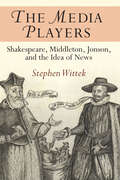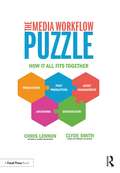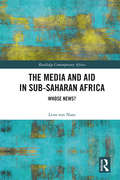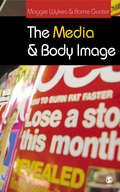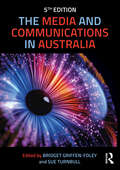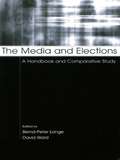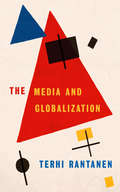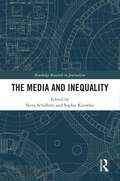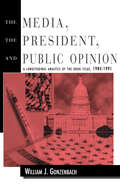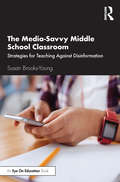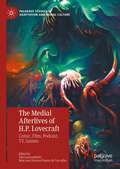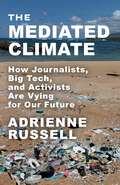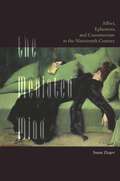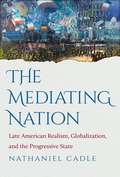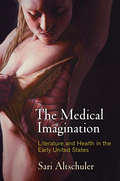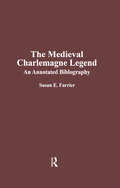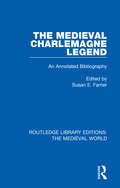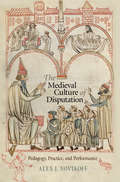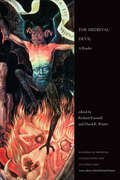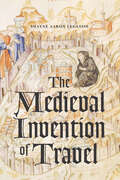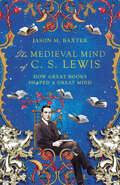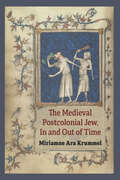- Table View
- List View
The Media Players
by Stephen WittekThe Media Players: Shakespeare, Middleton, Jonson, and the Idea of News builds a case for the central, formative function of Shakespeare's theater in the news culture of early modern England. In an analysis that combines historical research with recent developments in public sphere theory, Dr. Stephen Wittek argues that the unique discursive space created by commercial theater helped to foster the conceptual framework that made news possible. Dr. Wittek's analysis focuses on the years between 1590 and 1630, an era of extraordinary advances in English news culture that begins with the first instance of serialized news in England and ends with the emergence of news as a regular, permanent fixture of the marketplace. Notably, this period of expansion in news culture coincided with a correspondingly extraordinary era of theatrical production and innovation, an era that marks the beginning of commercial theater in London, and has left us with the plays of William Shakespeare, Ben Jonson, and Thomas Middleton. Book jacket.
The Media Workflow Puzzle: How It All Fits Together
by Chris LennonThis edited collection brings together a team of top industry experts to provide a comprehensive look at the entire media workflow from start to finish. The Media Workflow Puzzle gives readers an in-depth overview of the workflow process, from production to distribution to archiving. Pulling from the expertise of twenty contributing authors and editors, the book covers topics including content production, postproduction systems, media asset management, content distribution, and archiving and preservation, offering the reader an understanding of all the various elements and processes that go into the media workflow ecosystem. It concludes with an exploration of the possibilities for the future of media workflows and the new opportunities it may bring. Professionals and students alike looking to understand how to manage media content for its entire lifecycle will find this an invaluable resource.
The Media and Aid in Sub-Saharan Africa: Whose News? (Routledge Contemporary Africa)
by Lena von NasoNews coverage on Africa is closely connected not only with how Western audiences see the continent, but also with how a wide Western audience builds its opinion on issues that carry consequences for the public's and governments' support and policy towards development aid. The Western media reinforce a picture of a continent that drowns in chaos, is dominated by conflicts, diseases, corruption and failed democratisation. Whose interests lie behind that? How does foreign news on sub-Saharan Africa emerge, which actors are relevant in its making, and on the basis of what interests do these actors shape the coverage that is then presented as 'neutral information' to a broad international audience? Closely examining the relationship between foreign correspondents of international news media and humanitarian organisations, Lena von Naso shows how the aid and media sectors cooperate in Africa in a unique way. Based on more than 70 interviews with foreign correspondents and aid workers operating across Africa, the book argues that the changing nature of foreign news and of aid is forcing them to form a deep co-dependency that is having a serious and largely unnoticed effect on Western news coverage. This comprehensive examination of a new paradigm will interest students and scholars of media and journalism, African studies, development and humanitarian studies and the aid and media communities operating across Africa.
The Media and Body Image: If Looks Could Kill
by Barrie Gunter Maggie WykesBlaming the media for reproducing and extolling unrealistic female bodies has almost become a popular truism. Even medical opinion notes that the media can influence young women to starve themselves and therefore act as a possible causal factor of disordered eating. Yet surprisingly, little work has addressed either the nature of media representations of the body, or the ways in which audiences interpret and use such images in our contemporary cultural context. The Media and Body Image addresses this lack and: - Draws together literature from sociology, gender studies and psychology - Brings together new empirical work on both media representations and audience responses - Offers a broad discussion of this topic in the context of socio-cultural change, gender politics, and self-identity.
The Media and Communications in Australia
by Sue Turnbull Bridget Griffen-FoleyAt a time when the traditional media have been reshaped by digital technologies and audiences have fragmented, people are using mediated forms of communication to manage all aspects of their daily lives as well as for news and entertainment. The Media and Communications in Australia offers a systematic introduction to this dynamic field. Fully updated and expanded, this fifth edition outlines the key media industries – from print, sound and television to film, gaming and public relations – and explains how communications technologies have changed the ways in which they now operate. It offers an overview of the key approaches to the field, including a consideration of Indigenous communication, and features a ‘hot topics’ section with contributions on issues including diversity, misinformation, algorithms, COVID-19, web series and national security. With chapters from Australia’s leading researchers and teachers in the field, The Media and Communications in Australia remains the most comprehensive and reliable introduction to media and communications from an Australian perspective. It is an ideal student text and a key resource for teachers, lecturers, media practitioners and anyone interested in understanding these influential industries.
The Media and Elections: A Handbook and Comparative Study (European Institute for the Media Series)
by David Ward Bernd-Peter LangeThis comparative study brings together academics and practitioners who work in the field of media and elections to provide a set of national case studies and an analysis of the legal and regulatory frameworks that are employed by nation states to ensure that the media perform according to certain standards during election periods. In setting out the legal and regulatory framework each chapter provides an account of the socio-political conditions and media environment in each of the countries and subsequently details the laws that govern the print and broadcast media during election campaign periods. The countries included are France, Germany, Italy, Russia, South Africa, the United States, and the United Kingdom. A set of reflections by a Member of the European Parliament and a set of recommendations for good practice in media and elections are also included. Thus, the book is organized to provide a practical guide so that it can be used as a handbook.
The Media and Globalization
by Terhi Rantanen`This is a necessary and very original book that really does address the lack of attention to media in previous discussions about globalization' - James Lull, San Jose State University There is practically no globalization without media and communications. Yet this relationship is so obvious it is often overlooked. Rantanen challenges conventional ways of thinking about globalization and shows it cannot be understood without studying the role of the media. This book offers: - a clear and accessible overview of globalization and the pivotal role of the media - an introduction to the concepts and theories of globalization - empirical data on the production and consumption of media - a methodology for relating individual, local experiences to the global picture Rantanen has made this complex and huge subject very accessible by using personal histories and pictures to engage the reader. It will be invaluable to students in international media, cultural studies, communications and international relations.
The Media and Inequality (Routledge Research in Journalism)
by Steve Schifferes Sophie KnowlesThis book brings together a vast range of pre-eminent experts, academics, and practitioners to interrogate the role of media in representing economic inequality. It explores and deconstructs the concept of economic inequality by examining the different dimensions of inequality and how it has evolved historically; how it has been represented and portrayed in the media; and how, in turn, those representations have informed the public’s knowledge of and attitudes towards poverty, class and welfare, and political discourse. Taking a multi-disciplinary, comparative, and historical approach, and using a variety of new and original data sets to inform the research, studies herein examine the relationship between media and inequality in UK, Western Europe, and USA. In addition to generating new knowledge and research agendas, the book generates suggestions of ways to improve news coverage on this topic and raise the level of the debate, and will improve understanding about economic inequality, as it has evolved, and as it continues to develop in academic, political and media discourses. This book will be of interest to academics and practitioners alike in the areas of journalism, media studies, economics, and the social sciences, as well as political commentators and those interested more broadly in social policy.
The Media and Religious Authority
by Stewart M. HooverAs the availability and use of media platforms continue to expand, the cultural visibility of religion is on the rise, leading to questions about religious authority: Where does it come from? How is it established? What might be changing it? The contributors to The Media and Religious Authority examine the ways in which new centers of power and influence are emerging as religions seek to “brand” themselves in the media age. Putting their in-depth, incisive studies of particular instances of media production and reception in Asia, Africa, Latin America, and North America into conversation with one another, the volume explores how evolving mediations of religion in various places affect the prospects, aspirations, and durability of religious authority across the globe.An insightful combination of theoretical groundwork and individual case studies, The Media and Religious Authority invites us to rethink the relationships among the media, religion, and culture.The contributors are Karina Kosicki Bellotti, Alexandra Boutros, Pauline Hope Cheong, Peter Horsfield, Christine Hoff Kraemer, Joonseong Lee, Alf Linderman, Bahíyyah Maroon, Montré Aza Missouri, and Emily Zeamer, with an afterword by Lynn Schofield Clark.
The Media, the President, and Public Opinion: A Longitudinal Analysis of the Drug Issue, 1984-1991 (Routledge Communication Series)
by William J. GonzenbachUsing a broadened conceptualization of agenda setting, this volume's objective is to examine the drug issue from mid-1984 to mid-1991 to determine how drug-related issues and events -- both real and fabricated -- and the primary agendas drove the issue over time. Based on this objective, four questions are posed: * How did the media structure interpretations of drug issues and events? * How did the president structure public relations interpretations and presentations of issue and event information over time? * What were the interactions of the drug-issue agendas, the president's public relations agendas, the media, and the public, while controlling the policy agenda and a real-world measure of the severity of the drug problem? * How did the relationships of these agendas differ during the Reagan and Bush presidencies? These questions were addressed with detailed content analyses of the media agenda over time, the presidential public relations agenda over time, and a multivariate ARIMA analysis of the time series agendas. No previous studies to date have addressed and modeled these agendas simultaneously with ARIMA modeling methods.
The Media-Savvy Middle School Classroom: Strategies for Teaching Against Disinformation
by Susan Brooks-YoungThe Media-Savvy Middle School Classroom is a practical guide for teachers of Grades 5-8 who want to help their students achieve mastery of media literacy skills. Today’s fake news, alternative facts, and digital manipulations are compromising the critical thinking and well-being of middle grade learners already going through significant personal changes. This actionable book prepares teachers to help their students become informed consumers of online resources. Spanning correct source use, personal versus expert opinions, deliberate disinformation, social media, and more, these ready-to-use activities can be integrated directly into existing language arts and mathematics lesson plans.
The Medial Afterlives of H.P. Lovecraft: Comic, Film, Podcast, TV, Games (Palgrave Studies in Adaptation and Visual Culture)
by Tim Lanzendörfer Max José Dreysse Passos de CarvalhoMedial Afterlives of H.P. Lovecraft brings together essays on the theory and practice of adapting H.P. Lovecraft’s fiction and the Lovecraftian. It draws on recent adaptation theory as well as broader discourses around media affordances to give an overview over the presence of Lovecraft in contemporary media as well as the importance of contemporary media in shaping what we take Lovecraft’s legacy to be. Discussing a wide array of medial forms, from film and TV to comics, podcasts, and video and board games, and bringing together an international group of scholars, the volume analyzes individual instances of adaptation as well as the larger concern of what it is possible to learn about adaptation from the example of H.P. Lovecraft, and how we construct Lovecraft and the Lovecraftian today in adaptation. Medial Afterlives of H.P. Lovecraft is focused on an academic audience, but it will nonetheless hold interest for all readers interested in Lovecraft today.
The Mediated Climate: How Journalists, Big Tech, and Activists Are Vying for Our Future
by Adrienne RussellTo what extent does journalism deserve blame for the failure to address climate change over the last thirty years? Critics point out that climate coverage has often lacked necessary urgency and hewed to traditional notions of objectivity and balance that allowed powerful interests—mainly fossil fuel companies—to manufacture doubt. Climate journalism, however, developed alongside the digital media landscape, which is characterized by rampant misinformation, political polarization, unaccountable tech companies, unchecked corporate power, and vast inequalities. Under these circumstances, journalism struggled, and bad actors flourished, muddling messages while emissions mounted and societies struggled to avert catastrophe.The Mediated Climate explores the places where the climate and information crises meet, examining how journalism, activism, corporations, and Big Tech compete to influence the public. Adrienne Russell argues that the inadequate response to climate change is intertwined with the profound challenges facing the communications environment. She demonstrates that the information crisis is driven not only by technological changes but also by concentrated power that predates the rise of digital media companies. Efforts to improve climate coverage must take into account the larger social and material contexts in which journalism operates and the broader power dynamics that shape public discourse. Drawing on interviews with journalists and activists, Russell considers the ways recent movements are battling misinformation. She offers timely recommendations to foster engagement with climate issues and calls on readers to join in efforts to reshape the media landscape to better serve the public interest.
The Mediated Mind: Affect, Ephemera, and Consumerism in the Nineteenth Century
by Susan ZiegerHow did we arrive at our contemporary consumer media economy? Why are we now fixated on screens, imbibing information that constantly expires, and longing for more direct or authentic kinds of experience? The Mediated Mind answers these questions by revisiting a previous media revolution, the nineteenth-century explosion of mass print. Like our own smartphone screens, printed paper and imprinted objects touched the most intimate regions of nineteenth-century life. The rise of this printed ephemera, and its new information economy, generated modern consumer experiences such as voracious collecting and curating, fantasies of disembodied mental travel, and information addiction. Susan Zieger demonstrates how the nineteenth century established affective, psychological, social, and cultural habits of media consumption that we still experience, even as pixels supersede paper. Revealing the history of our own moment, The Mediated Mind challenges the commonplace assumption that our own new media lack a past, or that our own experiences are unprecedented.
The Mediating Nation
by Nathaniel CadleBy the early twentieth century, as Woodrow Wilson would later declare, the United States had become both the literal embodiment of all the earth's peoples and a nation representing all other nations and cultures through its ethnic and cultural diversity. This idea of connection with all peoples, Nathaniel Cadle argues, allowed American literary writers to circulate their work internationally, in turn promoting American literature and also the nation itself. Reexamining the relationship between Progressivism and literary realism, Cadle demonstrates that the narratives constructed by American writers asserted a more active role for the United States in world affairs and helped to shift global influence from Europe to North America. From the novels of Henry James, William Dean Howells, and Abraham Cahan to the political and social writings of Woodrow Wilson and W. E. B. Du Bois, Cadle identifies a common global engagement through which realists and Progressives articulated a stronger and more active cultural, political, and social role for the United States.
The Medical Imagination: Literature and Health in the Early United States (Early American Studies)
by Sari AltschulerIn 1872, Ralph Waldo Emerson wrote, "Science does not know its debt to imagination," words that still ring true in the worlds of health and health care today. The checklists and clinical algorithms of modern medicine leave little space for imagination, and yet we depend on creativity and ingenuity for the advancement of medicine—to diagnose unusual conditions, to innovate treatment, and to make groundbreaking discoveries. We know a great deal about the empirical aspects of medicine, but we know far less about what the medical imagination is, what it does, how it works, or how we might train it.In The Medical Imagination, Sari Altschuler argues that this was not always so. During the eighteenth and nineteenth centuries, doctors understood the imagination to be directly connected to health, intimately involved in healing, and central to medical discovery. In fact, for physicians and other health writers in the early United States, literature provided important forms for crafting, testing, and implementing theories of health. Reading and writing poetry trained judgment, cultivated inventiveness, sharpened observation, and supplied evidence for medical research, while novels and short stories offered new perspectives and sites for experimenting with original medical theories.Such imaginative experimentation became most visible at moments of crisis or novelty in American medicine, such as the 1790s yellow fever epidemics, the global cholera pandemics, and the discovery of anesthesia, when conventional wisdom and standard practice failed to produce satisfying answers to pressing questions. Throughout the eighteenth and nineteenth centuries, health research and practice relied on a broader complex of knowing, in which imagination often worked with and alongside observation, experience, and empirical research. In reframing the historical relationship between literature and health, The Medical Imagination provides a usable past for contemporary conversations about the role of the imagination—and the humanities more broadly—in health research and practice today.
The Medieval Charlemagne Legend: An Annotated Bibliography (Medieval Bibliographies Series #11)
by Susan E. FarrierOriginally published in 1993, The Medieval Charlemagne Legend is a selective bibliography for the literary scholar, of historical and literary material relating to Charlemagne. The book provides a chronological listing of sources on the legend and man is split into three distinct sections, covering the history of Charlemagne, the literature of Charlemagne and the medieval biography and chronicle of Charlemagne.
The Medieval Charlemagne Legend: An Annotated Bibliography (Routledge Library Editions: The Medieval World #11)
by Susan E. FarrierOriginally published in 1993, The Medieval Charlemagne Legend is a selective bibliography for the literary scholar, of historical and literary material relating to Charlemagne. The book provides a chronological listing of sources on the legend and man is split into three distinct sections, covering the history of Charlemagne, the literature of Charlemagne and the medieval biography and chronicle of Charlemagne.
The Medieval Culture of Disputation: Pedagogy, Practice, and Performance (The Middle Ages Series)
by Alex J. NovikoffScholastic disputation, the formalized procedure of debate in the medieval university, is one of the hallmarks of intellectual life in premodern Europe. Modeled on Socratic and Aristotelian methods of argumentation, this rhetorical style was refined in the monasteries of the early Middle Ages and rose to prominence during the twelfth-century Renaissance. Strict rules governed disputation, and it became the preferred method of teaching within the university curriculum and beyond. In The Medieval Culture of Disputation, Alex J. Novikoff has written the first sustained and comprehensive study of the practice of scholastic disputation and of its formative influence in multiple spheres of cultural life.Using hundreds of published and unpublished sources as his guide, Novikoff traces the evolution of disputation from its ancient origins to its broader impact on the scholastic culture and public sphere of the High Middle Ages. Many examples of medieval disputation are rooted in religious discourse and monastic pedagogy: Augustine's inner spiritual dialogues and Anselm of Bec's use of rational investigation in speculative theology laid the foundations for the medieval contemplative world. The polemical value of disputation was especially exploited in the context of competing Jewish and Christian interpretations of the Bible. Disputation became the hallmark of Christian intellectual attacks against Jews and Judaism, first as a literary genre and then in public debates such as the Talmud Trial of 1240 and the Barcelona Disputation of 1263. As disputation filtered into the public sphere, it also became a key element in iconography, liturgical drama, epistolary writing, debate poetry, musical counterpoint, and polemic. The Medieval Culture of Disputation places the practice and performance of disputation at the nexus of this broader literary and cultural context.
The Medieval Devil: A Reader (Readings in Medieval Civilizations and Cultures)
by Richard Raiswell David R. WinterThe Medieval Devil is a unique collection of primary sources that examines the development of medieval society through the lens of how people perceived the devil. In exploring where and how Europeans discerned his presence, detected his machinations, and sought to counter his actions, readers will be afforded a new and important point of entry into medieval history. Each chapter begins with an introduction to familiarize readers with critical issues and to contextualize the primary sources against broader developments of the period. Questions for discussion and reflection, twelve black-and-white illustrations, and a short bibliography are included.
The Medieval Invention of Travel
by Shayne Aaron LegassieOver the course of the Middle Ages, the economies of Europe, Asia, and northern Africa became more closely integrated, fostering the international and intercontinental journeys of merchants, pilgrims, diplomats, missionaries, and adventurers. During a time in history when travel was often difficult, expensive, and fraught with danger, these wayfarers composed accounts of their experiences in unprecedented numbers and transformed traditional conceptions of human mobility. Exploring this phenomenon, The Medieval Invention of Travel draws on an impressive array of sources to develop original readings of canonical figures such as Marco Polo, John Mandeville, and Petrarch, as well as a host of lesser-known travel writers. As Shayne Aaron Legassie demonstrates, the Middle Ages inherited a Greco-Roman model of heroic travel, which viewed the ideal journey as a triumph over temptation and bodily travail. Medieval travel writers revolutionized this ancient paradigm by incorporating practices of reading and writing into the ascetic regime of the heroic voyager, fashioning a bold new conception of travel that would endure into modern times. Engaging methods and insights from a range of disciplines, The Medieval Invention of Travel offers a comprehensive account of how medieval travel writers and their audiences reshaped the intellectual and material culture of Europe for centuries to come.
The Medieval Mind of C. S. Lewis: How Great Books Shaped a Great Mind
by Jason M. BaxterC. S. Lewis had one of the great minds of the twentieth century.Mere ChristianityThe Problem of Pain
The Medieval Postcolonial Jew, In and Out of Time
by Miriamne Ara KrummelThe Medieval Postcolonial Jew, In and Out of Time studies violent temporal clashes that are written into the medieval vision of annus domini [the year of our Lord]. Christian temporality represents Jewish time as queerly oddly outmoded and advocating uncivil and socially disruptive behavior. Jewish temporality, in turn, records a marginalized people who work to rescue their embattled temporality from becoming a time forgotten and colonized. Through a select group of literature in Middle English, Latin, and Hebrew, as well as sixteen manuscript pictorials, author Miriamne Ara Krummel confronts the notion that annus domini time (whether disguised as CE or AD) figures as the universal standard. Krummel’s argument details how Other temporalities—ones outside and not like annus domini time—are cast as nonstandard and imagined as wholly devised out of stories that promote fear and terror, and are positioned as putative threats to the fabric of the temporal empire of Latin Christendom. Ultimately, the book reflects on the ways in which “common” time both marks and silences marginal identities and cultures and shows to what extent the dynamics of the medieval environment materialize in our modern world.
The Medieval Postcolonial Jew, In and Out of Time
by Miriamne Ara KrummelThe Medieval Postcolonial Jew, In and Out of Time studies violent temporal clashes that are written into the medieval vision of annus domini [the year of our Lord]. Christian temporality represents Jewish time as queerly oddly outmoded and advocating uncivil and socially disruptive behavior. Jewish temporality, in turn, records a marginalized people who work to rescue their embattled temporality from becoming a time forgotten and colonized. Through a select group of literature in Middle English, Latin, and Hebrew, as well as sixteen manuscript pictorials, author Miriamne Ara Krummel confronts the notion that annus domini time (whether disguised as CE or AD) figures as the universal standard. Krummel’s argument details how Other temporalities—ones outside and not like annus domini time—are cast as nonstandard and imagined as wholly devised out of stories that promote fear and terror, and are positioned as putative threats to the fabric of the temporal empire of Latin Christendom. Ultimately, the book reflects on the ways in which “common” time both marks and silences marginal identities and cultures and shows to what extent the dynamics of the medieval environment materialize in our modern world.
The Medieval Presence in Modernist Literature
by Jonathan UllyotJonathan Ullyot's The Medieval Presence in Modernist Literature rethinks the influence that early medieval studies and Grail narratives had on modernist literature. Through examining several canonical works, from Henry James' The Golden Bowl to Samuel Beckett's Molloy, Ullyot argues that these texts serve as a continuation of the Grail legend inspired by medieval scholarship of the late nineteenth and early twentieth centuries. Rather than adapt the story of the Grail, modernist writers intentionally failed to make the Grail myth cohere, thus critiquing the way a literary work establishes its authority by alluding to previous traditions. While the quest to fail is a modernist ethic often misconceived as a pessimistic response to the collapse of traditional humanism, the modernist writings of Eliot, Kafka, and Céline posit that the possibility of redemption presents itself only when hope has finally been abandoned.
